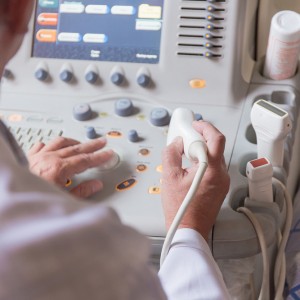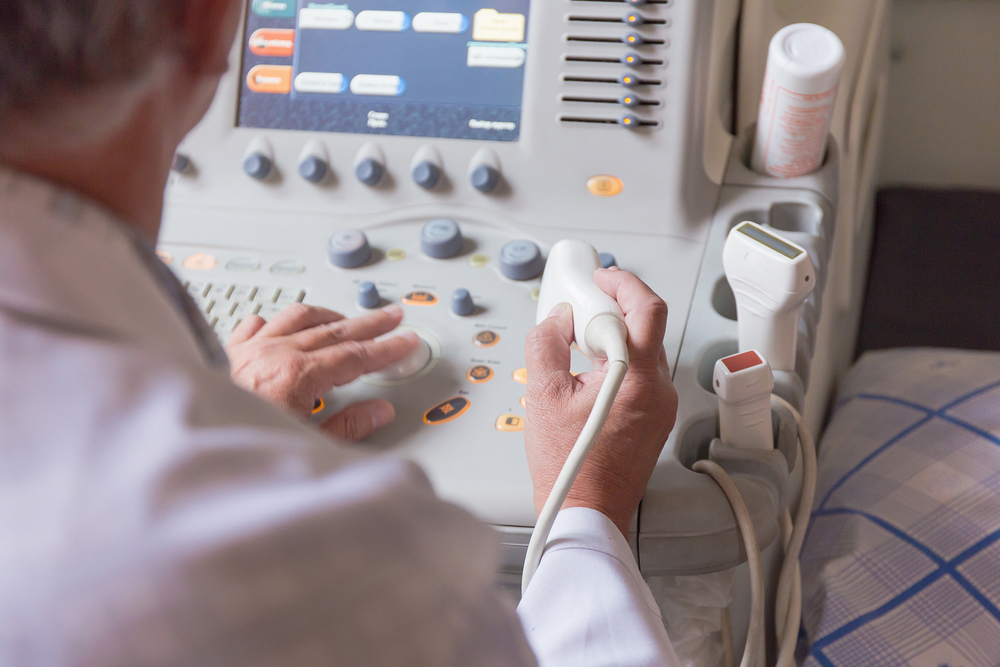 Houston’s UT Health Medical School will be a participant institution in an international, Phase III clinical trial recently launched to study the effectiveness and safety of using ultrasound in combination with a clot-busting medication for treatment of acute ischemic stroke. This randomized, double-blinded, placebo-controlled trial is projected to recruit some 830 patient subjects at approximately 60 sites worldwide. UTHealth Medical School site was the first participating institution to enroll a patient, Enrique Chapa, 75, of Houston.
Houston’s UT Health Medical School will be a participant institution in an international, Phase III clinical trial recently launched to study the effectiveness and safety of using ultrasound in combination with a clot-busting medication for treatment of acute ischemic stroke. This randomized, double-blinded, placebo-controlled trial is projected to recruit some 830 patient subjects at approximately 60 sites worldwide. UTHealth Medical School site was the first participating institution to enroll a patient, Enrique Chapa, 75, of Houston.
The sole pharmacologic therapy available for treating strokes caused by arterial blood clots is an intravenously administered tissue plasminogen activator (tPA). However, the ability of transcranial Doppler ultrasound energy to facilitate breaking up blood clots was first noted at UTHealth in 2004, with results of a Phase 2 safety and efficacy study that was published in the New England Journal of Medicine.
.
The paper, entitled “Ultrasound identification and lysis of clots,” (Stroke. 2004 Nov;35(11 Suppl 1):2722-5. Epub 2004 Sep 16) was authored by Andrei V Alexandrov, then of the University of Texas-Houston Medical School Department of Neurology and Radiology, Cerebrovascular Ultrasound and Center for Noninvasive Brain Perfusion Studies, Stroke Treatment Team. Results showed a 38 percent rate of arterial recanalization using ultrasound and tPA, compared 13 percent recanalization with tPA alone.
Dr. Alexandrov noted that poor recovery after systemic tissue plasminogen activator (tPA) therapy could result from the initial severity of ischemic insult and slow and incomplete thrombolysis, and that persisting arterial occlusions can be identified at bedside using portable diagnostic ultrasound by detecting residual flow signals around the thrombus (thrombolysis in brain ischemia [TIBI] flow grades).
He explains that a narrow-pulsed ultrasound beam can be steadily aimed at the thrombus/residual flow interface, exposing more thrombus surface and structures to tPA, and tPA activity can be enhanced with 2 MHz transcranial Doppler (TCD).
In the trial, a randomized, multi center, clinical trial called CLOTBUST (Combined Lysis of Thrombus in Brain ischemia using transcranial Ultrasound and Systemic tPA) trial showed a 49 percent rate of complete recanalization, or dramatic clinical recovery from stroke, within two hours after tPA bolus when tPA infusion was continuously monitored with TCD, compared with 30 percent among patients who received tPA without ultrasound monitoring.
“We hope this will be the definitive trial to see if the delivery of ultrasound in combination with tPA results in better outcomes than the use of tPA alone,” says Dr. Andrew Barreto, assistant professor of neurology and North American principal investigator for the current 2015 trial. “We will be assessing if the treatment leads to less disability and more independence for stroke victims.”
When a blood clot or thrombus is formed, strands of fibrin anchor red blood cells to one another, as it is these fibrin strands that form the clot’s lattice or structural matrix. The drug tPA works by converting plasminogen in the blood stream to plasmin, the active enzyme that dissolves fibrin. However, research has shown that the application of ultrasound energy during conventional intravenous tPA thrombolytic therapy can result in dramatic improvement in dissolution of blood clots and restoration of blood flow to the brain’s ischemic regions — an effect called SonoLysis that results from ultrasound pressure waves traveling through tissue inducing a mechanical force, which in turn causes displacement or strain in tissues.
When a tissue contains fluid compartments (such as blood), the ultrasound beam’s energy is transformed into fluid motion energy, a transformation called acoustic streaming. At very low pressures this streaming inside confined areas of complex tissues such as the brain will cause a mild stirring action. Acoustic streaming is therefore believed to be the primary agent of ultrasound-potentiated fibrinolysis in which additional fibrin binding sites are exposed to plasmin at the clot site. SonoLysis therefore represents a fundamentally innovative approach to treatment of ischemic stroke in which externally applied ultrasound energy can significantly enhance clot lysis potential of conventional thrombolytic therapy.
Cerevast Therapeutics, a Redmond, Washington based medical technology company with primary emphasis on developing treatments for acute ischemic stroke and other vascular disorders, is developing a non-invasive treatment for acute ischemic stroke known as sonothrombolysis, or SonoLysis for short. This treatment harnesses the acoustic energy from externally applied ultrasound to treat stroke-causing clots in the blood vessels of the brain.
Initial treatment of ischemic stroke typically occurs in the hospital emergency room. This is critical timeframe in which diagnostic assessments are being performed and treatment options are being evaluated. In the immediate period following onset of an ischemic stroke, approximately 32,000 neurons will die every second (1.9 million per minute), and in that same minute, the brain will lose 14 billion synapses — the vital intersection between neurons. Also lost in that minute are 7.5 miles of myelinated fibers, the insulating material found on the axon of neurons that is essential for proper functioning of the nervous system.
It is therefore crucial for treatment be initiated as quickly as possible in order to restore blood flow to the oxygen-deprived regions of the brain that are down-stream of the blood clot or thrombus. In order for treatments to be initiated quickly, however, they must also be easy to use given the often times hectic emergency room environment when treating life-or-death situations such as ischemic stroke.
Cerevast has developed a novel operator independent SonoLysis Headframe System called “Clotbust ER,” which employs multiple transducers operating at 2 MHz (the same frequency used in FDA-cleared TCD instruments). However, rather than being used as a diagnostic instrument for measuring blood flow velocity in the brain, the Clotbust ER is designed to deliver therapeutic ultrasound energy to the region of the occluded vessel in the brain as a treatment for ischemic stroke in patients eligible to receive intravenous thrombolytic therapy.
The device uses UTHealth technology licensed to Cerevast, which has developed the ClotBust-ER operator-independent head frame that delivers ultrasound through 16 individual probes. The device recently underwent an NIH-sponsored Phase II safety study. A sham device is used for the placebo-controlled portion of the trial.
Monitoring of blood flow in the brain with conventional single probe TCD devices is difficult to perform and typically requires a trained monographer, so having the ability to monitor intracranial blood flow during SonoLysis treatment is an attractive add-on feature that can provide clinicians the ability to assess recanalization of the occluded vessel on a real-time basis. Clotbust ER has potential to provide clinicians with the ability to not only deliver therapeutic ultrasound energy to stroke patients, but monitor recanalization at the same time.
The device is comprised of the 16 ultrasound transducers mounted on an adjustable head frame, allowing them to be fixed in place to administer therapeutic ultrasound in the principal brain regions where most cranial vessel occlusions are known to occur. The transducers do not require aiming since the device incorporates external features the self-align the transducers based on known anthropometric landmarks. Proprietary computer firmware controls the ultrasound parameters, in turn allowing the device to deliver the therapeutic levels of ultrasound energy necessary to achieve acoustic streaming and enhanced clot lysis within the occluded vessel of the brain without need for a trained sonographer.
Using this approach, Cerevast say they can significantly reduce the technical challenges associated with administration of transcranial ultrasound as a new treatment for ischemic stroke, thus extending the therapy’s reach and scope beyond dedicated stroke centers.
The company notes that monographers capable of detecting occluded cerebral artery segments are normally staffed in the larger, more sophisticated, stroke treatment capable hospital emergency departments (EDs), while smaller EDs more commonly administer tPA to stroke patients but generally are not staffed with monographers who have the necessary training or expertise to conduct ultrasound exams with conventional diagnostic TCD instruments. Consequently, the Clotbust ER device has been designed to address this by establishing a viable ultrasound enhanced thrombolytic solution for EDs capable of administering tPA. By incorporating operator independent features into the device, Cerevast’s objective is to enable emergency room personnel, paramedics and other health care professionals to readily employ this technology.
Dr. Barreto notes that the head frame device makes application of the ultrasound easier. “The first safety study was done with a diagnostic handheld probe placed against the temple, and medical personnel had to be trained to properly administer the ultrasound,” he explains, but with Cerevast’s device, the operator-independent head frame can be placed on the head with minimal training by any emergency room staff member.
Clotbust ER is designed for rapid deployment in the emergency room setting and has been engineered to non-invasively deliver therapeutic ultrasound energy to the region of the occluded vessel in the brain, and to be rapidly and easily deployed by virtually any emergency room staff to safely administer the ultrasound energy for SonoLysis therapy.
It is being initially developed as a therapeutic-only device, so it will not have monitoring capability during the administration of therapeutic ultrasound energy for stroke treatment.
Cerevast notes that data from five independent clinical studies has demonstrated that combining the acoustic energy of ultrasound with conventional intravenous (IV) tPA therapy dissolves blood clots more completely and provides patients with better long term clinical outcomes compared to IV tPA therapy alone. Based on the results of these studies, the Clotbust ER received European CE mark clearance in December 2011
The 2011 trial is entitled “Combined Lysis of Thrombus with Ultrasound and Systemic Tissue Plasminogen Activator (tPA) for Emergent Revascularization in Acute Ischemic Stroke (CLOTBUST-ER).“ Primary outcome measures include modified Rankin score ordinal shift analysis, and the primary objective is to compare clinical recovery rates (modified Rankin score ordinal shift analysis) at three months after stroke onset. The secondary outcome objective is to compare of rates of symptomatic intracerebral hemorrhage within 0-24 hours from initiation of treatment.
Dr. Alexei Alexandrov, who wrote the 2004 study report and is now a professor of neurology and director of the Division of Cerebrovascular Disease at the University of Alabama at Birmingham, is the global principal investigator of CLOTBUST-ER. The CLOTBUST ER Phase 3 Clinical Study is now enrolling Interim analysis #1 was completed on September 22nd, 2014, and enrollment continues.
The UTHealth trial will enroll patients at Memorial Hermann-Texas Medical Center, Memorial Hermann Southwest Hospital, and Baptist Beaumont Hospital. Dr. Barreto says patients at the latter two sites will be enrolled through the UTHealth stroke telemedicine program.
Sources:
UTHealth
Cerevast Therapeutics, Inc.
New England Journal of Medicine
clinicaltrials.gov
Image Credits:
UTHealth
Cerevast Therapeutics, Inc.


